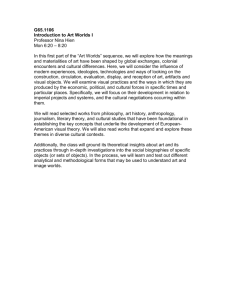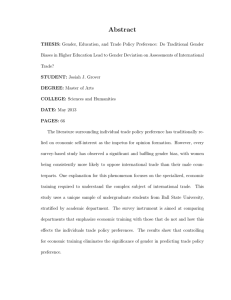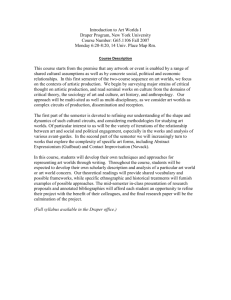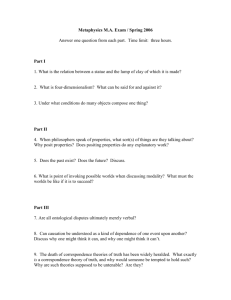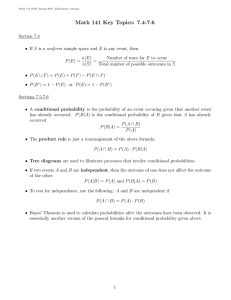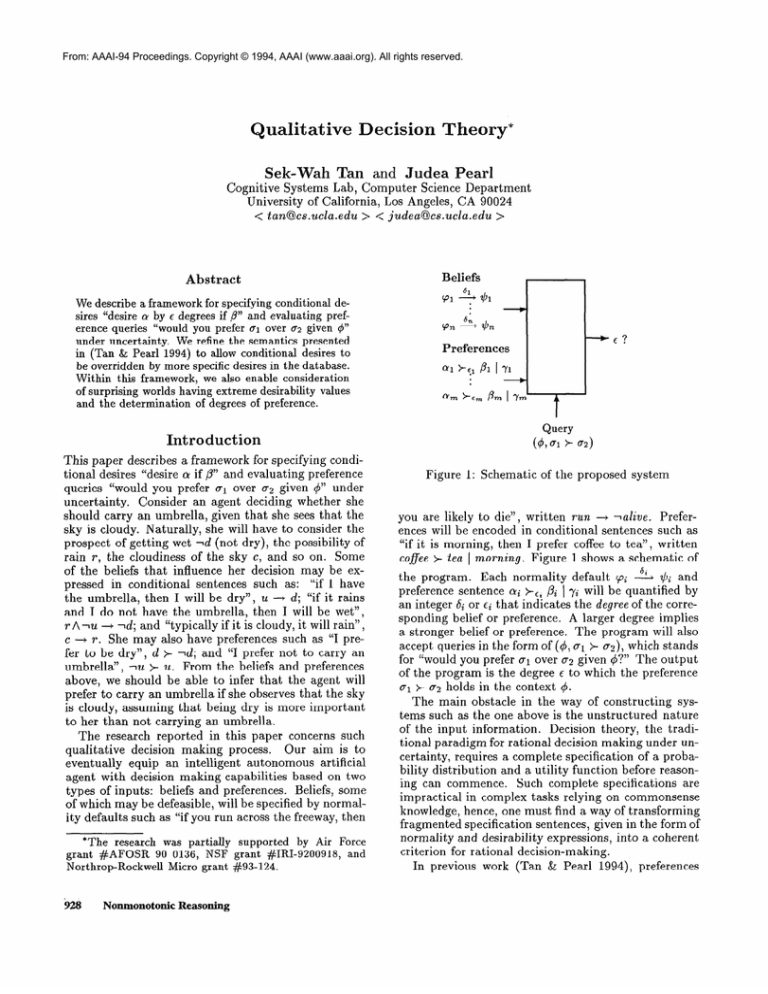
From: AAAI-94 Proceedings. Copyright © 1994, AAAI (www.aaai.org). All rights reserved.
Qualitative
Sek-Wah
Decision
Theory*
Tan and Judea Pearl
Cognitive Systems Lab, Computer Science Department
University of California, Los Angeles, CA 90024
< tan@cs.ucla.edu
> < judea@cs.ucda.edu
>
Abstract
We describe a framework for specifying conditional desires “desire CYby E degrees if ,8” and evaluating preference queries “would you prefer ~1 over ~2 given $”
under uncertainty.
We refine the semantics
presented
desires to
in (Tan & Pearl 1994) to allow conditional
be overridden by more specific desires in the database.
Within this framework,
we also enable consideration
of surprising worlds having extreme desirability values
and the determination
of degrees of preference.
Query
Introduction
(#‘Ol
This paper describes a framework for specifying conditional desires “desire o! if P,, and evaluating preference
queries “would you prefer ~1 over 02 given 4” under
uncertainty.
Consider an agent deciding whether she
should carry an umbrella, given that she sees that the
sky is cloudy. Naturally, she will have to consider the
prospect of getting wet ld (not dry), the possibility of
rain T, the cloudiness of the sky c, and so on. Some
of the beliefs that influence her decision may be expressed in conditional
sentences such as: “if I have
the umbrella, then I will be dry”, u --+ d; “if it rains
and I do not have the umbrella, then I will be wet”,
r A lu + ld; and “typically if it is cloudy, it will rain”,
c 3 T. She may also have preferences such as “I prefer to be dry”, d >- ld; and “I prefer not to carry an
umbrella”,
lu % u. From the beliefs and preferences
above, we should be able to infer that the agent will
prefer to carry an umbrella if she observes that the sky
is cloudy, assuming that being dry is more important
to her than not carrying an umbrella.
The research reported in this paper concerns such
qualitative
decision making process.
Our aim is to
eventually equip an intelligent autonomous
artificial
agent with decision making capabilities based on two
types of inputs: beliefs and preferences. Beliefs, some
of which may be defeasible, will be specified by normality defaults such as “if you run across the freeway, then
*The research
was partially
grant #AFOSR
90 0136, NSF
Northrop-Rockwell
Micro grant
‘928
Nonmonotonic Reasoning
supported
by Air
grant #IRI-9200918,
#93-124.
Force
and
Figure 1: Schematic
+
c2)
of the proposed
system
you are likely to die”, written run --+ luli2)e. Preferences will be encoded in conditional sentences such as
“if it is morning, then I prefer coffee to tea”, written
coflee > tea 1 morning.
Figure 1 shows a schematic of
Each normality default (pi --% $+ and
the program.
preference sentence cyi +Ez ,L$ 1 Ti will be quantified by
an integer Si or Ei that indicates the degree of the corresponding belief or preference. A larger degree implies
a stronger belief or preference. The program will also
accept queries in the form of (4, ul >- Q), which stands
for “would you prefer CT~over 02 given 4?” The output
of the program is the degree E to which the preference
crl + 02 holds in the context 4.
The main obstacle in the way of constructing
systems such as the one above is the unstructured nature
Decision theory, the tradiof the input information.
tional paradigm for rational decision making under uncertainty, requires a complete specification of a probability distribution and a utility function before reasonSuch complete specifications
are
ing can commence.
impractical in complex tasks relying on commonsense
knowledge, hence, one must find a way of transforming
fragmented specification sentences, given in the form of
normality and desirability expressions, into a coherent
criterion for rational decision-making.
In previous work (Tan & Pearl 1994), preferences
of the form o + la 1 /? were given ceteris paribum
(CP) semantics and interpreted as “a is preferred to
ICY other things being equal (ceteris paribum) in any ,B
world”. Such conditional preferences are called con&tionad desires and written D(cyI,@. The problem with
the CP semantics is that it does not handle specificity very well. In particular, if D(o) is a desire in
the database, we cannot subsequently express a desire
O(-lcrl,L?) for ICY in a more specific situation ,O (without modifying D( (Y) in the database as well). This is
unsatisfactory
as it is not uncommon
for us to subscribe to some (default) set of desires (e.g., desire to
be alive, to be rich, to be healthy) but subsequently
qualify these desires (e.g., desire to die for some noble
cause) for more specific situations. We would like to be
able to handle specificity without having to examine or
modify the desires that are already in the database.
In this paper we modify the CP semantics so that a
conditional desire is allowed to override a less specific
desire. We consider conditional desires of the form “if
p then a is desirable by degree E”, written o,(al/?),
where Q and /3 are well-formed formulas (wffs) and
e is an integer. We will assume that the preferences
of a reasoning agent may be represented by a preference ranking that is, by an integer-valued function
on worlds which corresponds to an order-of-magnitude
approximation
of the agent’s utility function.
Conditional desires will be interpreted as constraints on admissible preference rankings. We will interpret a conditional desire o(alp)
as “a, is preferred to la ceteris
paribum in any p world if allowed by the other conditional desires in the preference database”.
While the
CP semantics imposes cp-constraints
between worlds
that agree ceteris paribum, we have the additional requirement that a cp-constraint
be not overridden by
another cp-constraint
that is due to a more specific
conditional
desire. A conditional
desire is more specific than another if the former attempts to constrain
a smaller set of worlds than the latter. To strengthen
the system, we retain the principle of maximal indifference adopted in (Tan & Pearl 1994) and select from the
set of admissible preference rankings the most compact
rankings n+ (w).
Another problem with the proposal in (Tan & Pearl
1994) is that preference queries are evaluated by comparing “believable”
worlds.
These are worlds that
are ranked zero by the belief ranking, which is an
integer-valued function that scores the “believability”
of worlds. This excludes from consideration all worlds
that are surprising (to any degree) even though some
of the surprising worlds may have extreme positive or
This is unsatisfactory
as some
negative consequences.
extremely undesirable consequences
(e.g., getting hit
by a car), although unlikely, are not impossible,
and
some people would like to take such consequences into
consideration.
In this paper we weaken the notion of
believability to include worlds that are ranked no more
than some threshold 6. We also extend the notion of
preferential dominance and preferential entailment to
allow for the strength of the preference to be determined and for the conclusions to be qualified by a degree of confidence.
In the next two sections we will describe the above
extensions and improvements to the CP semantics. For
the sake of brevity, we will not consider the semantics
for normality defaults and will assume that we have
a belief model that processes the input defaults and
outputs a belief ranking. In the penultimate section,
we compare related work and in the conclusion,
we
summarize the contributions of this paper.
Conditional
Review
Desires
and Notation
In this section we explain some notation and review
some concepts that were introduced in (Tan & Pearl
1994).
We consider conditional
desires of the form
DE(alP), where CYand ,8 are wffs obtained from a finite
set of atomic propositions X = {Xl, X2, . . . , X,} with
the usual truth functionals A, V, and 1 and where E is
an integer. We will call CYthe desire, p the condition,
and E the degree (or strength) of the conditional desire
D, (ayIp). For simplicity we may write D(cK[/~) if the
degree of the desire is not relevant to the discussion or
if the degree is 1 (default value). When convenient we
will also use the common form (Y > ,B instead of YxVP.
A wff o depends on a proposition Xi if all wffs that
are logically equivalent to CYcontain the symbol Xi.
The set of propositions
that cv depends on is represented by S(a).
This set is referred to as the support of o, written support(a),
in (Doyle, Shoham, &
Wellman 1991). The set of propositions
that cu does
not depend on is represented by S(a) = X \ S(o).
A
world is simply a truth assignment on the set of atomic
propositions.
We will write w = a5 to refer to the truth
assignment that assigns true to a and false to b. We say
that two worlds agree on a proposition if they assign
the same truth value to the proposition.
Two worlds
agree on a set of propositions
if they agree on all the
propositions
in the set. We say that w and v are Sequivalent, written w -S V, if w and Y agree on the set
S C X. We call D( c~Iw ) a sp eci fi c conditional desire if
w Ys a wff of the form r\y xi, where 2i = Xi or -‘Xi.
(As a convention we will use the same symbol w to refer
to the unique model of a wff w.) We assume that the
preferences of the reasoning agent may be represented
by a preference ranking 7rIT,
which is an integer-valued
function on the set of worlds s1. The preference rank
of a world corresponds to an order-of-magnitude
approximation
of the utility associated with the world.
The intended meaning of a ranking is that the world
w is no less preferred than the world v if x(w) >, a(v).
Given a non empty set of worlds IV, we write 7rr*
(IV)
for min,eW r(w) and r*(W) for max,sW n(w). If W
is empty, we adopt the convention that nr*(IV) = 00
and r*(W) = -oo.
Belief Revision
929
We associate with each conditional
desire a set of
worlds, called its context, which defines the worlds that
the conditional desire constrains.
1 (Context)
Let D(c~lw) be a specific
The context
of D(a(w),
written
is defined as
ur ,-+
Fir
t
uv -
t
UT
Definition
conditional
C&W),
desire.
(1)
The context of a
C(a) p), is defined
D(al,B),
to be u,,,~~C(CU, w).
conditional
desire
Given a context C, we write Cr for {V b y I v E
C) where y is a wff. We write C(p) to represent the
context of the conditional desire p.
Specificity
In normal discourse, we have no difficulty accommodating general expressions of preferences that are subsequently qualified in more specific scenarios. For example, I desire to be alive D(a), yet I am willing to die
for some noble cause D(la(c).
In the CP interpretation, this pair of desires would be inconsistent. In such
which has a
a situation, we will usually allow D(la(c),
more specific condition, to override the unconditional
desire D(a).
If a conditional
desire attempts to constrain a subset of the worlds constrained by another
desire, then we declare the former to be more specific
than the latter. We define a conditional desire p to be
more specific than conditional desire p’ if the context
of p is a strict subset of the context of p’.
Definition 2 (Specificity)
tional desires.
p is more
Let p and p’ be condispecific than p’, written
P * P’, if C(P) c C(P’).
Given this definition, one might wonder whether a
simpler definition of specificity would suffice, one that
considers only the conditions of the conditional desires.
The simple proposal would be to declare a conditional
desire p = D(a],B) to be more specific than another
p’ = D(a’IP’)
if th e condition of p, p implies the condition of p’, p’, that is, /3 3 p’ and not vice versa. This
simple proposal is not appropriate for our semantics
because it declares the conditional desire D(ala) to be
more specific than D(a) even though the two desires
impose the same constraints. Although the simple definition is not suitable in general, it is sufficient when
we restrict ourselves to a special type of conditional
desires that we name simple.
Definition
3 (Simple Desires) A conditional desire
D(alP)
is simple if Q! and ,O have disjoint support.
Theorem
and p’ =
1 (Simple
D(a’IP’).
If
Specificity)
p is simple
Let p = D(a)/?)
and p 1 p’ but
p’ 3 p, then p + pt.
Thus our definition of specificity coincides with the intuitive notion of when one conditional desire is more
specific than another.
930
NonmonotonicReasoning
Figure 2: Applicable
constraints
in umbrella
example.
written
Admissible
Rankings
In the CP semantics, ceteris paribum constraints are
imposed independently
by every conditional desire in
the database.
Definition 4 (CP-Constraints)
v +E v’ is a ceteris paribum constraint
(cp-constraint)
of a conditional desire D&YIP)
if v E C&F,W)
and v’ E
C,,(Q,W)
for some w k p. c is a cp-constraint
of
a set D if it is the cp-constraint for some p E D.
No consideration
is given to possible conflicts among
these constraints to accommodate
specificity.
Let us consider how a cp-constraint may be “overridden”. Consider a preference database consisting of two
desires, the desire for good weather (no rain) D(lr)
and the desire to not carry the umbrella D(-lu).
The
cp-constraints
of these desires are Ur 5 UT t ur and
Ur + iir > ur. Suppose that we would like to qualify
our desire not to carry the umbrella by adding, to our
database, the conditional desire to carry the umbrella
if it is raining D(ulr).
The cp-constraint
of D(uIr)
is ur F Er, which is in direct conflict with the cpconstraint Ur >- ur of D(lu).
In this case we will like
the cp-constraint ur t ?ir to override the cp-constraint
Zr > ur as D(uIr) is more specific than D(lu).
We say that two cp-constraints
are in competition if
they attempt to constrain the same worlds. For example the competing cp-constraints
of w +E v are w +El v
and v ~~1 w.
Definition 5 (Admissible
Rankings)
A preference
ranking r is admissible
with respect to a set of conditional desires D if for ad1 cp-constraints
w sE u of
p E D either
n(w) 2 n(v) + E
(2)
or there exists another sentence p’ E D such that p’ > p
and p’ induces a cp-constraint that competes with w >E
u.
If there exists a ranking that is admissible with respect
to a set of conditional desires D, then we say that D is
consistent. An example of an inconsistent
set is D =
{D(u), D(lu)}.
Neither desire is more specific than
the other and their cp-constraints
are not overridden.
Their cp-constraints are u + 21 and u t u, respectively,
and these imply r(u) > n(E) and T(U) > r(u) since the
default degree is 1. There is no ranking that can satisfy
both inequalities simultaneously.
Table
1: Preference
ranking in the umbrella
example
In the umbrella example described above, we have
the preference database {D(~T), D(lu),
D(u~Y)}. For
a preference ranking to be admissible with respect to
the database, it has to satisfy the cp-constraints
that
are not overridden.
These cp-constraints
are shown
in figure 2 (an arrow w + v represents w > v, or
n(w) > n(v) since the default degree is 1). Here the
cp-constraint
of D(lu),
Ur > ur, is overridden by the
cp-constraint ur > ‘ii;r of D(u~Y) which is more specific.
In (Tan & Pearl 1994) we strengthened the semantics by adopting the principle of maximal indifference,
which states that a reasoning agent is indifferent between two worlds unless a preference is explicitly communicated or can be inferred. We take the same approach here and select the most compact rankings from
the set of admissible preference rankings. The reader
is referred to (Tan & Pearl 1994) for a more complete
discussion of the principle.
Definition 6 (The T+ Ranking) Let D be a consistent set of conditional desires and let II be the set of
rankings admissible with respect to D. A IT+ ranking
is an admissible ranking that is most compact,
that
iS
c
W,vEn
In+64 - ~+wI I
c
IW - +I
(3)
W,VEa
for all 7r E II.
Let us reconsider the umbrella example.
The cpconstraints of the preference database (see figure 2)
leads us to the most compact admissible preference
ranking n+. The ranks are shown in table 1 where r-n
is an integer.
Preference
Normality
Evaluation
Defaults
In evaluating preference queries, it is important that
we be able to take into account the relative likelihoods
of the worlds.
The role of normality defaults in our
proposal is to keep track of esoteric yet unlikely situations (just in case they become a reality) but not allow
them to interfere with mundane decision making. For
the sake of brevity, we will not describe in detail the
treatment of normality defaults.
We will instead assume that we have a belief model that accepts normality defaults representing qualitative expressions of beliefs and outputs a belief ranking K, an integer-valued
Table 2: Ranks in the fire example
function on worlds which scores the “believability”
of
the worlds. An example of such a belief model can be
found in (Goldszmidt
1992). Adopting Goldszmidt ‘s
convention,
worlds with belief rank 0 are believable
and an increasing rank indicates increasing surprise
(or decreasing believability).
We also assume that belief ranks are non negative. We will write ~(4; ai) to
represent the ranking that results after the execution
of action 0i given context 4. &($; ai) will represent
the set of S-believable worlds, namely, the set of worlds
that have a ~(4; ai) rank not greater than S.
In (Tan & Pearl 1994) consideration
of the possible scenarios were restricted to the O-believable worlds
6’ while surprising (K > 0) were completely ignored
regardless of their preference ranks. This is unsatisfactory, as some of the surprising worlds may carry
extreme positive or negative utilities.
For example,
consider fire insurance. Many people, despite believing
fires (f) t o b e unlikely, still want to consider insuring
their belongings (i). Table 2 shows a reasonable set of
values for the beliefs and preferences associated with
this example. If we were to concern ourselves only with
the O-believable worlds, then we would conclude that
we prefer not to insure.
In this paper we extend preference consideration
to
S-believable worlds &, where 6 may be either a threshold specified by the user or an output value indicating
a degree of confidence that qualifies the evaluation of
the query. A preference query will be confirmed with
confidence at least S if it is confirmed with confidence
S - 1 and also confirmed by considering S-believable
worlds.
Preferential
Dominance
Preferential dominance (Tan & Pearl 1994) is a binary relation between sets of worlds which is derived
from a preference ranking on worlds. Preferential dominance examines the three types of worlds that characterize the compared sets: the common possibilities, the
additional possibilities, and the excluded possibilities.
When considering whether we would prefer the set W
over the set V (see figure 3), we imagine that the set V
represents the possibilities currently available to us and
that the set W represents the set of new possibilities.
Let us consider the case when W C V. Since W excludes some possibilities from V, we have to compare
these excluded possibilities
(in V \ W) with the new
Belief Revision
931
Table 3: Ranks in the umbrella
wcv
aDominating
General
w3v
q Dominated
Figure 3: Interesting
cases for W +n V
possibilities offered by W. If the excluded possibilities
are ranked lower than those that remain then W protects us from those excluded possibilities and we should
prefer W to V. In the case when V c W, W provides
more possibilities.
If these additional possibilities (in
W \ V) are ranked higher than the current possibilities, W provides an opportunity for improvement over
the situation in V and again we should prefer W to V.
In the general case, if W and V have some possibilities in common, then these common possibilities (in
W II V) can be disregarded. If the additional possibilities (in W \ V) are ranked higher than the excluded
possibilities
(in V \ W), then we will prefer W to V.
In figure 3, W r-dominates
V, written W >n V, if
the worlds in the dominating set are preferred over the
worlds in the dominated set. We generalize the notion
of preferential dominance to allow a preference query
to be confirmed with a degree indicating the strength
of the confirmation.
Definition
7 (Preferential
Dominance)
Let T be
a preference
ranking and det W and V be two subsets
of s2. We say that W n-dominates
V by E, written
W >i V, if and only if one of the following holds:
1. E = 0 when W = V,
2. x*(W)
3. n,(W
2 T*(V\
W) +E
\ V) 2 n*(V)
when W C V,
+ E when W > V, or
4. n,( W \ V) >_ x* (V \ W) + c otherwise.
We write W +=
v $s: w.
V if W +k
V for some
E 2
0 but
The definition of preferential dominance
in (Tan &
Pearl 1994) corresponds to +k and is therefore slightly
stronger than +x.
To evaluate the preference query (4,gr + a~) with
degree E and confidence 6, we compare the set of ibelievable worlds, i = 0, . . . , 6, resulting from executing 01 given 4 to those resulting from executing 02
given 4, and test if the former preferentially
dominates
the latter by E in all the most compact preference rankings.
Definition
8 (Preferential
Entailment)
Let D be
a set of conditional desires and K. be some belief ranking on” R. 4 preferentially
entails 01 >- 62 with
degree E >_ 0 and confidence S given (D, K), written
4 /+I
h m), if and onb if
f+?+
932
01)
example
+;+
Nonmonotonic Reasoning
&I%
c2)
for all n+ rankings of D and all i = 0,. . . ,S. We say
that a preference query (4, ~1 + (~2) is confirmed with
degree E and confidence 6.
We say that 4 preferentially entails ~1 sE ~72with absolute confidence if 4 ka( 01 +E 02) for all S > 0. We
also write 4 kB(ar > (~2) if
for all r+ rankings of D and all i = 0, . . . , 6.
Example
Let us reconsider the umbrella story and the query
“would you prefer to have the umbrella given that
the sky is cloudy?“,
(c; u > 1~).
We have the preference database {D(Tr),
D(lu),
D(uIr)}.
Let us assume that we have the defaults database {c + r}. For
this example we will adopt the belief model in (Goldszmidt & Pearl 1992; Pearl 1993). First we process the
defaults database to get the resulting belief rankings
K(W). Next, as in table 3, we list the possible worlds,
given that the sky is cloudy, and obtain the belief ranking K(W) and the ?r+ preference ranking (from table l),
where m is some fixed integer. K’(c; u) = { ucr} and
has a minimum rank of m + 1, while K’(c; V.J) = {Ucr}
with a maximum rank of m. Therefore the preference
query (c; u + lu) is confirmed with degree 1 and confidence zero’. Unfortunately the preference query cannot be confirmed with absolute confidence.
Comparison
with Related
Work
The assertability
of conditional
ought statements of
the form “you ought to do A if C” is considered in
(Pearl 1993). The statement is interpreted as “if you
observe, believe, or know C, then the expected utility
resulting from doing A is much higher than that resulting from not doing A”. The treatment in (Pearl
1993) assumes, however, that a complete specification
of a utility ranking on worlds is available and that the
scale of the abstraction
of preferences is commensurable with that of the abstraction of beliefs. Another
problem is that the conclusions of the system are not
invariant under a lateral shift of the utility ranking
‘It is unfortunate
that the phrase “confidence zero” conjures up the idea of a total lack of confidence which is definitely not the intended meaning of “being confirmed with
confidence
zero”.
The intended
meaning is “considering
only situations which are serious possibilities”.
because the system endows worlds toward which the
agent is indifferent with special status; for example,
utility rankings ~1 and 7r2, where 7rz(w) = nr(w) + 1,
may admit different conclusions.
In (Boutilier 1994)) expressions of conditional preferences of the form “1(oIp) - if ,0 then ideally o” are
given modal logic semantics in terms of a preference ordering on possible worlds. I(oIp) is interpreted as “in
the most-preferred
worlds where ,8 holds, a holds as
well” . This interpretation
places constraints only on
the most-preferred
,&worlds, allowing only ,&worlds
that also satisfy o to have the same “rank”.
This
contrasts with the CP semantics, which places constraints between pairs of worlds.
In discussing the
reasoning from preference expressions to actual preferences (which we here call preference queries), (Boutilier
1994) suggests that worlds could be assumed to be
as preferred or as ideal as possible, parallelling the
assumption
made in computing
the K+ belief ranking (Goldszmidt
1992) that worlds are as normal as
possible.
While it is intuitive to assume that worlds
would gravitate towards normality because abnormality is a monopolar scale, it is not at all clear that worlds
ought to be as preferred as possible since preference is
a bipolar scale. This assumption of maximal preference can lead us to some very surprising conclusions
though.
Suppose that the only desire we have is to
have bananas if we are alive D( bananas I alive). The
assumption will surprisingly deduce that our most desirable worlds include those where we are lalive. The
X+ rankings actually compacts the worlds away from
the extremes thus minimizing unjustified preferences.
It remains to be seen whether the I operator corresponds closely with the common linguistic use of the
word “ideally” .
Ceteris paribum comparatives,
relative desires and
goal expressions have been considered
in (Wellman
& Doyle 1991; Doyle, Shoham,
& Wellman
1991;
Doyle & Wellman 1994). These accounts are similar to
our semantics for unquantified unconditional
desires.
However, in their semantics (and also in Boutilier’s
system), preference constraints apply strictly to worlds
satisfying the condition part of the preference statement.
We believe that our interpretation
captures
a broader use of conditional
desires in common discourse. For example, we often find an expression such
as “if the light is off, we prefer to have the light on”,
D(Zight I llight).
This expression does not confine
itself only to worlds satisfying -light.
Instead, it actually compares worlds with light against those with
ilight.
Although the desire light contradicts the condition, it is nevertheless an accepted way of specifying
under what states of belief the preference would be
invoked.
of conditional desires, generalizes the notion of believability to allow consideration of surprising worlds, and
extends preferential dominance so that the evaluation
of preference queries may be qualified by an integer
indicating the strength of the confirmation.
The computational issues remain to be investigated, and further
evaluation of the system needs to be done.
Acknowledgments
We would like to thank the three anonymous reviewers
for their constructive comments and suggestions.
The
first author is supported in part by a scholarship from
the National Computer Board, Singapore.
eferences
Boutilier, C. 1994. Toward a logic of qualitative decision theory. In Doyle, J.; Sandewall, E.; and Torasso,
P., eds., Principles of Knowledge Representation
and
Reasoning:
Proceedings
of the Fourth International
Conference
(KR94).
Bonn, Germany: Morgan Kaufmann.
Doyle, J., and Wellman, M. P. 1994. Representing
preferences as ceteris paribus comparatives. In Hanks,
S.; Russell, S.; and Wellman, M., eds., Working Notes
of the AAAI Spring Symposium, 69-75.
Doyle, J .; Shoham, Y.; and Wellman, M. P. 1991.
The logic of relative desires. In Sixth International
Symposium on Methodologies for Intelligent Systems.
Goldszmidt,
M., and Pearl, J. 1992. Reasoning with
qualitative probabilities can be tractable. In Proceedings of the Eigth Conference
on Uncertainty in Artificial Intelligence,
112-120.
Goldszmidt,
M. 1992. Qualitative Probabilities:
A
Normative Framework for Commonsense
Reasoning.
Ph.D. Dissertation, University of California Los Angeles, Cognitive Systems Lab., Los Angeles. Available
as Technical Report (R-190).
Pearl, J. 1993. From conditional oughts to qualitative
decision theory. In Proceedings of the Ninth Conference on Uncertainty in Artificial Intelligence,
12-20.
Tan, S.-W., and Pearl, J. 1994. Specification and evaluation of preferences for planning under uncertainty.
In Doyle, J.; Sandewall, E.; and Torasso, P., eds.,
Principles of Knowledge Representation
and Reasoning: Proceedings of the Fourth International
ConferB onn, Germany: Morgan Kaufmann.
ence (KR94).
Wellman, M. P., and Doyle, J. 1991. Preferential
semantics for goals. In Proceedings of the Ninth National Conference
on Artificial Intelligence,
698-703.
Conclusion
This work refines the CP semantics (Tan & Pearl 1994)
in three ways: it enables the handling of specificity
Belief Revision
933

